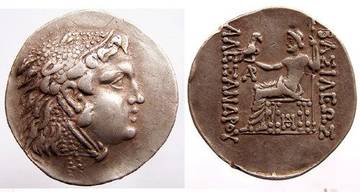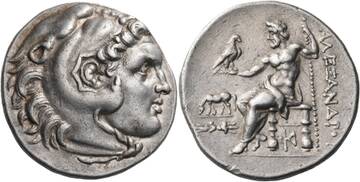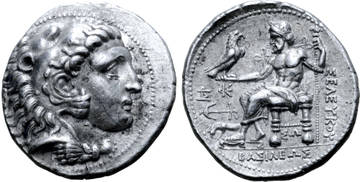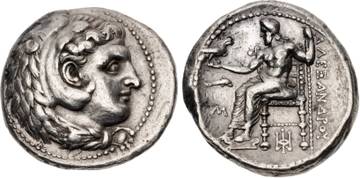какова вообще экономическая подоплёка в чеканке этих монет,
ведь в казне было полно трофейного персидского золота?
Судя по всему - абсолютно никакой. Маленький тираж, минимальное количество дошедших до нас экземпляров говорит о том, что их раздали в качестве бонуса к выплате ветеранам похода. Ровно как и декадрахмы Пора - ветеранам Индийского похода...
Про количество трофейного золота мы помню как-то давно обсуждали тут - Золото Персидского царства
Весьма занятные описания с лотов-декадрахм сохраню тут в виде цитат.
Alexander's conquests "liberated" tons of gold and silver that had been locked away for centuries in the Great King's treasuries in Sardes, Susa, Persepolis and Babylon. Mint masters soon set to work turning this huge haul into coins, which were paid out to Alexander's soldiers and high officials in staggering quantities. However, the silver decadrachm denomination, worth 10 Attic drachms and 2.5 tetradrachms, was struck in limited numbers, indicating they were presentation pieces intended for only the top tier of Macedonian officers. Only three decadrachm reverse varieties are known. Their extreme rarity -- today perhaps 25-30 examples are known to have survived -- makes it highly likely that these pieces were handed out by Alexander himself at a special ceremony, perhaps the one recorded at Susa in 324 BC where the great conqueror assembled his army and distributed up to 20,000 talents to his Macedonian veterans. The bidder on this piece thus has an opportunity to acquire a coin that, with a high degree of likelihood, could have passed through the hands of Alexander the Great.
В первой цитате, в конце абзаца - оригинальный маркетинговый ход - внушить биддеру, что эту монету вполне мог держать в руках сам АМ. 
In all of human history, there have been but very few individuals whose accomplishments are recounted again and again undimmed by time, whose legends have grown only brighter with the passing of the years, and whose names can stir fierce emotion and wonder at a distance of millennia. Alexander is perhaps the greatest of all such paragons of humanity, whose life and exploits are the near-incredible stuff of myth and fable.
Silver dekadrachms, be they of Athens, Syracuse, Akragas or Carthage, have ever been amongst the most desired and sought-after of ancient coins by virtue of their impressive size and weight, and the large canvas they presented for the showcasing of the engraver's art. Though considered 'rare', the surviving dekadrachms of Syracuse number in the high hundreds or low thousands, and those of Athens in the dozens. Fewer than twenty dekadrachms of Alexander are known to exist today - figurative grains of sand on a beach amidst the hundreds of thousands of surviving tetradrachms, drachms, staters and other fractions. The extreme rarity of Alexander's dekadrachms has therefore contributed an aura of unobtainability to the mystery of this most iconic coinage. Missing from most of the world's major institutional collections, the majority of the examples known today originated from the 1973 'Babylon' Hoard (sometimes also referred to as the Mesopotamia Hoard), and a smaller 1989 find that Martin Price believed to be a part of the original 1973 deposit. The eight coins that are known to have come from these two groups form the backbone of the Dekadrachm corpus.
Struck in three emissions from a mint generally considered to be at Babylon, but possibly Susa or Ekbatana, the dekadrachms formed part of a massive conversion of bullion seized from the Persian Royal treasuries at Susa and Persepolis - some 180,000 Attic talents (4,680 metric tons) were liberated from those vaults, converted by decree of the King into ready coinage to meet the expenses of his vast empire and to pay his beloved soldiers. That so few examples of this large denomination survive today is potentially indicative of a special significance or purpose for these coins. It is certainly tempting to think - as many often have - that they represent presentation pieces intended for certain men of rank, and that Alexander, who was well known for his love of giving gifts, may have distributed them personally. In reality though, their low survival rate is probably due to the impracticality of the denomination, since the ubiquitous tetradrachm was the more common and more convenient medium of payment.
Regardless of its intended purpose, and though it represents only a small splinter that survives of Alexander's great vision, today his dekadrachms are one of the most tangible artefacts of his reign, and amongst the greatest prizes of ancient Greek numismatics.






















